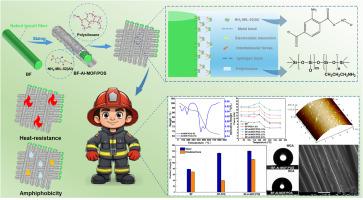双功能Al-MOF/聚硅氧烷纳米复合施胶剂增强玄武岩纤维的热机械性能和两疏性
IF 7.3
2区 材料科学
Q1 CHEMISTRY, APPLIED
引用次数: 0
摘要
传统的浆料涂布在玄武岩纤维(BFs)表面,限制了其耐热性和表面润湿性,在阻燃服装、耐高温防尘袋等特殊功能纺织品的应用领域,尤其影响了BFs原有优异耐热性的发挥。将NH2-MIL-53(Al)金属有机骨架(mof)与水溶性聚硅氧烷(POS)结合制备了一种新型纳米复合施胶剂,以改善mof的热机械性能和双疏性。该组合物模拟了BFs的主要成分来构建拓扑结构,其中Al-MOFs的无机部分主要负责增强粗糙度和耐热性,而POS的有机部分则需要调解化学非均质性和成膜性。与裸bf相比,加尺寸bf的力学性能显著提高,室温下的断裂力和伸长率分别从8.04 cN提高到21.1 cN,从1.58%提高到2.64%,分别提高了162.4%和67.1%。在250°C和400°C的温度下,颗粒状生物燃料的热力学性能保持率分别保持在95%和85%以上,而裸露的生物燃料的热力学性能在250°C和400°C的温度下,与室温下的原始值相比,急剧下降到50%和40%。同时,当水与二碘甲烷的接触角分别为140.1°±0.6°和111.2°±0.9°时,BFs具有表面两疏性。这项工作为构建多功能表面提供了工程意义,从而广泛拓宽了BFs在纺织品领域的应用潜力。本文章由计算机程序翻译,如有差异,请以英文原文为准。

Dual-functional Al-MOF/polysiloxane nano-composite sizing agent for enhanced thermomechanical properties and amphiphobicity of basalt fibers
Traditional sizing agent coated on the surface of Basalt Fibers(BFs) limits its heat-resistance and surface wettability in the application field of special functional textiles, such as fire-retardant apparel and high-temperature-resistant dustproof bag, etc., especially affects the display of BFs' original excellent heat resistance. A novel nanocomposite sizing agent combining NH2-MIL-53(Al) metal-organic frameworks (MOFs) with a water-soluble polysiloxane (POS) has been prepared to improve both the thermomechanical and amphiphobic properties of BFs. The composition mimics the main compositions of BFs to construct a topology, where the inorganic part of Al-MOFs is mainly responsible for enhancing roughness and heat-resistance and the organic part of POS is needed to mediate chemical heterogeneity and film forming property. The sized BFs exhibit significantly enhanced mechanical properties compared to the naked BFs, with the breaking force and elongation increasing from 8.04 cN to 21.1 cN and from 1.58 % to 2.64 % at room temperature, about 162.4 % and 67.1 %, respectively. The retention rate of thermomechanical properties of the sized BFs maintains over 95 % at 250 °C and over 85 % even at 400 °C, while those of the naked BFs diminishes drastically to 50 % at 250 °C and 40 % at 400 °C, comparing with their original value at room temperature. Simultaneously, the surface amphiphobicity of BFs is achieved with the contact angles of water and diiodomethane being 140.1° ± 0.6° and 111.2° ± 0.9°, respectively. This work provides engineering implications for constructing multi-functional surfaces and thereby extensively broadens the application potential of BFs in the realm of textiles.
求助全文
通过发布文献求助,成功后即可免费获取论文全文。
去求助
来源期刊

Progress in Organic Coatings
工程技术-材料科学:膜
CiteScore
11.40
自引率
15.20%
发文量
577
审稿时长
48 days
期刊介绍:
The aim of this international journal is to analyse and publicise the progress and current state of knowledge in the field of organic coatings and related materials. The Editors and the Editorial Board members will solicit both review and research papers from academic and industrial scientists who are actively engaged in research and development or, in the case of review papers, have extensive experience in the subject to be reviewed. Unsolicited manuscripts will be accepted if they meet the journal''s requirements. The journal publishes papers dealing with such subjects as:
• Chemical, physical and technological properties of organic coatings and related materials
• Problems and methods of preparation, manufacture and application of these materials
• Performance, testing and analysis.
 求助内容:
求助内容: 应助结果提醒方式:
应助结果提醒方式:


